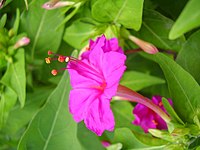
Photo from wikipedia
ETHNOPHARMACOLOGICAL RELEVANCE Pistachio hull has traditionally been used to treat peptic ulcer, hemorrhoids, oral and cutaneous wounds. AIM OF THE STUDY On the basis of its traditional uses and previous… Click to show full abstract
ETHNOPHARMACOLOGICAL RELEVANCE Pistachio hull has traditionally been used to treat peptic ulcer, hemorrhoids, oral and cutaneous wounds. AIM OF THE STUDY On the basis of its traditional uses and previous pharmacological reports, a bioassay guided fractionation procedures on pistachio (Pistacia vera L.) hulls was performed to define the fractions and bioactive compound that are responsible for wound healing activity of hulls. MATERIAL AND METHODS A bioassay-guided fractionation of the total extract (MeOH 80%) of Pistacia vera L. hulls was carried out to evaluate wound healing activity by scratch assay on NIH/3T3 murine fibroblast cells. A combination of solvent-solvent partitioning, column chromatography, preparative thin layer chromatography and crystallization were used to obtain fractions/sub-fractions and pure compound. The wound healing potential of isolated compound was examined by fibroblasts migration and proliferation using scratch assay and CFSC dilution assay, respectively. In addition, we evaluated the gene expression of some inflammatory markers which are involved in healing process using Real Time PCR. Chemical structure of active compound was elucidated by spectrometric methods. RESULTS Due to the higher wound healing activity of CHCl3 fraction from P. vera hulls, it was fractionated by successive chromatographic techniques to yield the active compound. 3-Epimasticadienolic acid was isolated and crystallized as a white powder. This active compound (200 μg/ml) significantly increased the fibroblast proliferation and migration, resulting in reduction of the scratch area about 45%. It showed a strong inhibitory effect on gene expression of IL-6 and TNF-α, and a stimulation effect on NF-κB gene expression at the same dose. CONCLUSION The present study supported the traditional uses of P. vera hulls for wound-healing and 3-epimasticadienolic acid showed significantly potent on wound repair.
Journal Title: Journal of ethnopharmacology
Year Published: 2019
Link to full text (if available)
Share on Social Media: Sign Up to like & get
recommendations!